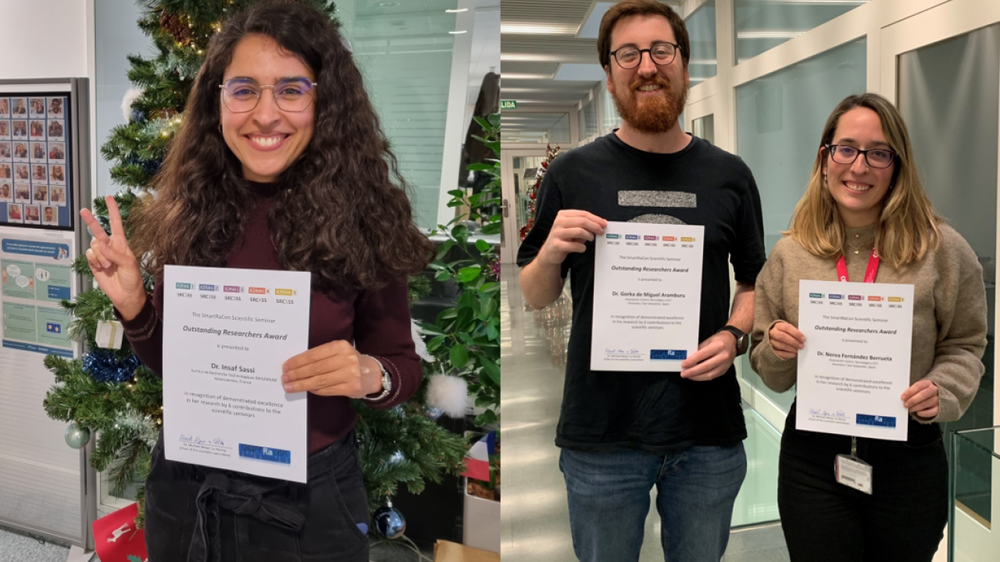SmartRaCon Scientific Seminar honours three scientists for outstanding contributions

IRT Railenium / CEIT
The Smart Rail Control Consortium (SmartRaCon) consisting of DLR, GMV-NSL, RAILENIUM and CEIT has organised the SmartRaCon Scientific Seminar since 2019. As a final highlight, three scientists were awarded for their outstanding contributions to the seminars:
Dr. Nerea Fernández Berrueta (CEIT, Donostia / San Sebastian, Spain):
In the SmartRaCon Scientific Seminar, Nerea Fernández Berrueta presented publications related to the evolution in railway communication systems. GSM-R is an interoperable track-to-radio technology used nowadays by many infrastructure managers. However, it became obsolete with an end of support planned by 2030. Moreover, it does not accomplish the requirements for the current applications. Then, there is a need for an evolution in railway communication systems. In order to research in this railway field, different tools from CEIT have been designed and implemented. The purpose of each one is different. While Channel Characterization Tool (CCT) is capable of measuring the performance of the available communication technologies geolocating each result at a specific point on the track, the Channel Emulator Tool (CET) emulates in the laboratory the on-site communication technologies in terms of IP level, and the Saboteur (SAB) allows injecting faults in the specific ETCS environment. Using these tools allows knowing how the communication technology behaves on-site and testing different applications in the laboratory which supports the evolution of the communications, contributes to a faster deployment with lower cost.
Dr. Insaf Sassi (IRT Railenium, Valenciennes, France):
In the SmartRaCon Scientific Seminar, Insaf Sassi has published six articles related to safety and dependability of onboard train integrity and train positioning functions, and autonomous trains. Railway signaling systems are in continuous progress to enhance competitiveness of the railway sector and cope with the evolution of the railway industry and market needs. Among the objectives is to increase the capacity of the European rail network, in particular by enabling moving block operation in a cost-effective way. Therefore, traditional signaling systems relying on track circuits or axle counters for train position detection and train integrity monitoring have to be substituted by on-board modules which must ensure that the train is moving safely and integer during its journey. To help implement and specify these new on-board function, safety analyses and formal verification methods are proposed to specify the safety requirements and formally verify the functional and safe behaviour of such new sub-systems. In addition, In the recent progress towards autonomous trains, and similarly to the case of autonomous cars, the autonomous driving components (ADS, ADAS, or ATO) basically provide the so-called perception layer or unit (sometimes including sensor fusion). These components implement artificial intelligence (AI) modules for the assessment of events and their relevance around the system, i.e., to provide the situational awareness. The use of such AI modules aims to help recognizing the environment and build a reliable and trustworthy environment model usable for complex automation tasks. Determining the AI perception functions in an exhaustive way is required, starting with identifying the perception functions currently performed within conventional trains (i.e., with a human driver and driving staff).
Dr. Gorka De Miguel Aramburu (CEIT, Donostia / San Sebastian, Spain):
In the SmartRaCon Scientific Seminar, Gorka De Miguel Aramburu presented publications related to on-board train positioning and train integrity. On-board train positioning, apart from reducing track-side equipment, is a key technology for ensuring safety by preventing collisions, maintaining the headway between trains and real-time train tracking. On-board train integrity is also vital in order to ensure safety, by reducing accidents due to the separation of the train components, at the same time as it enables ETCS level 3 moving block concept operation. Therefore, both on-board train positioning and on-board train integrity are indispensable elements to enable future railway systems. As railways continue to evolve, the ongoing focus on improving on-board train positioning and integrity will be essential for meeting the growing demands of the rail sector.
In the five SmartRaCon Scientific Seminars deep insights into the scientific achievements which are improving the railways in Europe were given with more than 50 scientific contributions organised in France, Germany and Spain. It was closely linked to the projects X2Rail-1 to X2Rail-5. Within the end of the Projects X2Rail-4 and X2Rail-5 this year the scientific program of the Shift2Rail Joint Undertaking is ending and therefore the collective research of Smart Rail Control Consortium.
All publications in the context of the SmartRaCon seminar can be found HERE (number 37-40).
Further information:
